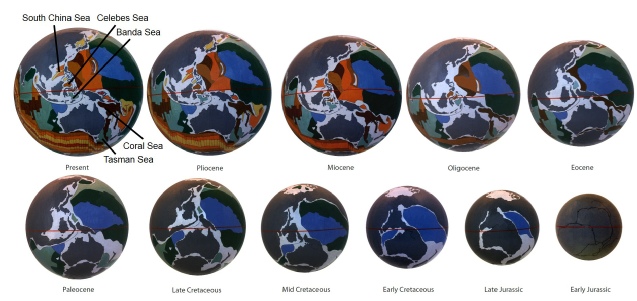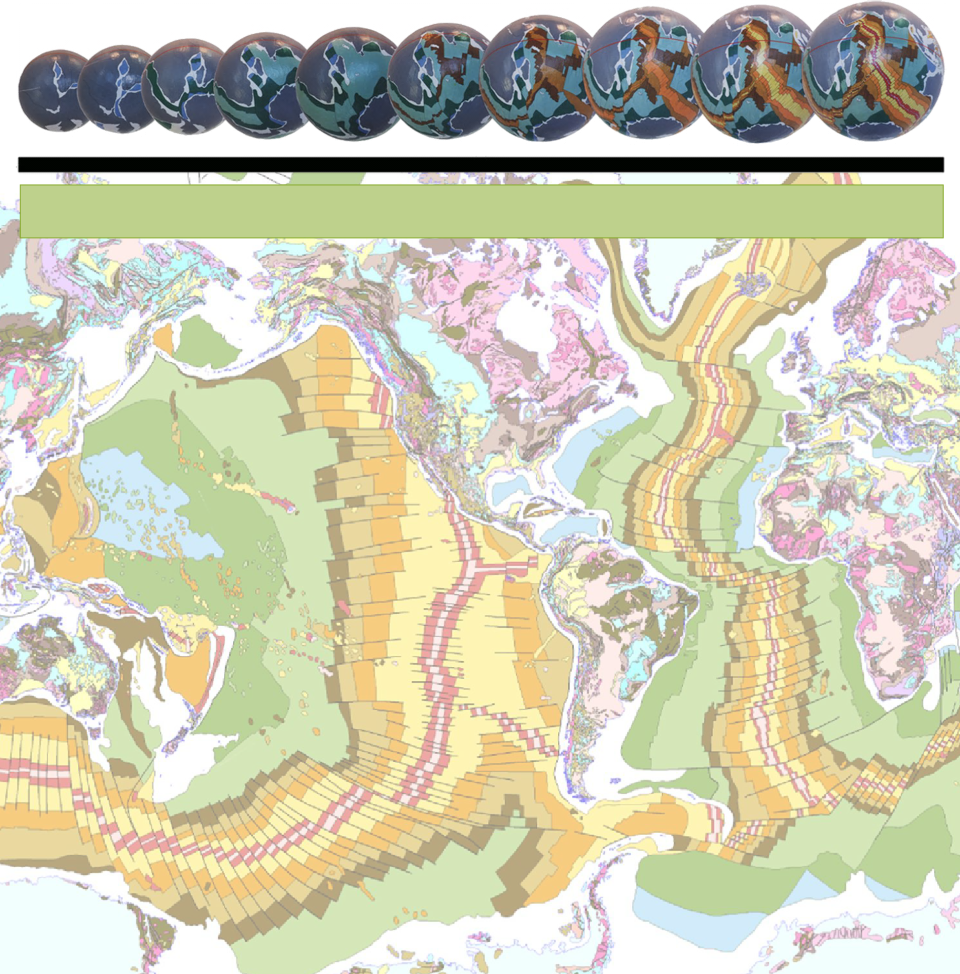SOUTH EAST ASIAN SEAS
The South East Asian region comprises the Philippine, South China, Celebes, Banda, and Java Seas. In this region the present-day South East Asia to New Guinea and Japanese Island chains represent complex island-arc systems. Plate tectonic reconstructions on a constant sized Earth are particularly vague when it comes to reconstructing South East Asia.
On conventional reconstructions this region is represented by small remnant crustal fragments, which are inferred to have existed at the eastern end of a large ancient Tethys Ocean where it merged with an even larger Panthalassa Ocean. During closure of both the Tethys and Panthalassa Oceans, the South East Asian Seas were then interpreted to represent marginal or back-arc basins. These basins were further separated from the various island-arcs by spreading along zones of inferred crustal subduction and deep trench development.

Southeast Asian and Southwest Pacific Basin Expansion Tectonic small Earth spreading history, extending from the present-day back to the early-Jurassic.
The development of the South East Asia basins and seas on an Expansion Tectonic Earth is complex and progressive. Small Earth model studies show that development within this region was intimately associated with the formation and subsequent plate interaction of the North Pacific oceanic plate. On these small Earth models the region is shown to represent the fragmented remains of ancient marine and continental sedimentary basins, as well as associated volcanic and island-arc activity.
The South East Asian region initially formed during early-Jurassic times. This region represents an area of marine basin opening, accompanied by deposition of sediments, and was located between the early Australian, North American, and Chinese continents. These basins first formed in conjunction with the initial rupturing and opening of the North Pacific Ocean. At that time, sediments eroded from the surrounding lands were being redeposited within the newly formed marine basins. These sediments were mixed with volcanic rocks, erupted along the precursors to the modern mid-ocean-ridge spreading zones, to form the early island-arc systems. Remnant sediments from this early opening event are now preserved as both continental shelf and marine plateau sediments, which are exposed as the South East Asian islands and submerged plateaux throughout the South East Asian Sea region.
Development of the South East Asia region has been further complicated by the plate motion history of Australia, relative to Asia, during opening of both the Pacific and Indian Oceans. Progressive crustal extension and opening between each of these continents occurred during late-Cretaceous to Pliocene times which resulted in opening of the South China, Celebes, and Banda Seas, as well as fragmentation of the early South East Asian island-arc system.
The crustal fragments making up the South East Asian region have since undergone complex clockwise rotation, crustal fragmentation, plate interaction, and on-going island-arc volcanism. These events all occurred during an extended period of southeast to northwest crustal extension between the Asian and Australian continental plates.
This interpretation of the South East Asia region contrasts strongly with the plate tectonic requirement for continental collision, the closure of pre-existing Tethys and Panthalassa Oceans, and complex subduction of the Australian and North Pacific plates beneath the Asian and Philippine plates.
SOUTHWEST PACIFIC REGION
The Southwest Pacific Ocean region is also structurally complex and comprises the Coral and Tasman Seas. The region is predominantly made up of remnants of ancient seafloor crust and marine sediments. These sediments were initially deposited and later fragmented during Cretaceous to Paleocene times and again during Miocene to present-day times. The region has been further complicated by crustal plate motion and plate interaction occurring along the margins of the Indo-Australian and Pacific plates.
The southwest Pacific Ocean region on Expansion Tectonic small Earth models represents the fragmented remains of earlier marine basins and sediments, deposited within an early pre-Triassic South Pacific Ocean basin. Initially, this area opened as a marine basin during pre-Triassic times. The newly formed basin then formed part of the early South Pacific Ocean, prior to merging with the North Pacific Ocean during the Triassic Period.
During pre-Triassic times, West Antarctica and New Zealand were assembled adjacent to Australia and South America. Subsequent rifting and opening between South America, New Zealand, and West Antarctica initiated formation of the South Pacific Ocean. During Triassic to early-Jurassic times, New Zealand and New Caledonia were separated from Australia during opening of the Tasman Sea. These then remained attached to Ecuador in Central America until final separation from South America during the mid-Jurassic times.
During the mid- to late-Jurassic an early New Zealand and New Caledonian continent comprising the Coral Sea plateau, Lord Howe Rise, and New Zealand island-arc complex were well established. This ancient continent then further fragmented and was partly submerged to form the present Southwest Pacific region. Seafloor spreading first developed in the South Pacific Ocean and this spreading extended west during the Cretaceous into the Tasman Sea. This event further isolated the Lord Howe Rise and New Zealand continent from Antarctica and Australia.
On an Expansion Tectonic Earth, the Tongan to South Solomon and New Hebrides trench and island-arc systems represent complex zones of plate interaction between the New Zealand and New Caledonia continental plate and the South Pacific Ocean plate margins. This complex interaction developed during on-going changes in Earth surface area and surface curvature over time. The interaction of these plates resulted in a slow clockwise rotation of the southwest Pacific Ocean region along each of the established trench and arc systems. In addition, the New Zealand and New Caledonian plate was further fragmented and displaced during the Cenozoic Era.
The rapid development of symmetric-style seafloor spreading in the South Pacific Ocean then resulted in further opening of the southwest Pacific Ocean region during the Cenozoic. Complex plate interaction and motion along the Kermadec and Tongan trench and arc systems again accompanied this opening during the early-Miocene. This crustal motion was also related to movement along the Alpine Fault system of New Zealand, which continues to the present-day.
On an Expansion Tectonic Earth, the southwest Pacific Ocean basin region cannot be reconciled with conventional plate tectonic reconstructions. Instead, this region simply represents a complex interplay of extensional crustal motion and opening between Australia, North America, South America, and Antarctica in conjunction with opening of the North and South Pacific Oceans during on-going changes to Earth radius and surface curvature.


